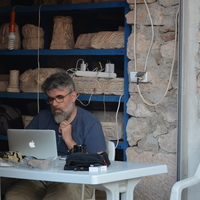
Charlene Vella
Dr Charlene Vella is Senior Lecturer in the Department of Art and Art History at the University of Malta. She read for an undergraduate degree at the University of Malta in History of Art, which she followed with an M.A. also from the University of Malta for which she was awarded a Distinction. She has successfully completed her Ph.D. at the University of Warwick where she was the recipient of a full scholarship. Her PhD research titled "In the Footsteps of Antonello da Messina: The Antonelliani in Sicily and Venice in the Late Fifteenth and Early Sixteenth Centuries" was carried out under the tutelage of Dr Donal Cooper (University of Cambridge).
Dr Vella has attended and participated in seminars and conferences abroad including La civilta comunale italiana organised by the Scuola di alti studi dottorali, Universita di Firenze (San Gimignano); the University of Edinburgh New Directions in the Renaissance conference; a paper on "The Antonelliani in Context" as part of the University of Warwick History of Art Department Research Seminars on 13 March 2013; RSA2016; the Barcelona Movement and Mobility in the Medieval Mediterranean (6th–15th centuries); the Warwick Re-Imagining the Mediterranean: trans-cultural networks in the early modern world conference; the Warburg The Art of the Poor in the Late Middle Ages and Renaissance; the University of Cambridge Centre for Visual Culture ‘Reconstruction: Methods and Practices in Research, Exhibitions, and Conservation; and RSA2020. She will be delivering a paper at the upcoming Bruges Symposium XXII for the Study of Underdrawing and Technology in Painting.
She has since 2018 convened the Dynamics of Mediterranean artistic interaction in the Late Middle Ages and Renaissance Periods conference at the Valletta Campus. Dr Vella directs research projects on Medieval and Renaissance art and she is a member of the Malta Planning Authority's Design Advisory Committee.
She is the Academic Coordinator for ERASMUS students and Undergraduate dissertations for the Department of Art and Art History, and a member of the Faculty of Arts' Student Requests Committee and the Course Catalogues & Programmes Committee.
Dr Vella was awarded the Premio Antonello da Messina for the section Studi Antonelliani on 14 April in a ceremony held in Rome by the Associazione Culturale Antonello da Messima.
Supervisors: Donal Cooper and Mario Buhagiar
Address: OH303, Faculty of Arts, University of Malta, Msida, MSD2080
Dr Vella has attended and participated in seminars and conferences abroad including La civilta comunale italiana organised by the Scuola di alti studi dottorali, Universita di Firenze (San Gimignano); the University of Edinburgh New Directions in the Renaissance conference; a paper on "The Antonelliani in Context" as part of the University of Warwick History of Art Department Research Seminars on 13 March 2013; RSA2016; the Barcelona Movement and Mobility in the Medieval Mediterranean (6th–15th centuries); the Warwick Re-Imagining the Mediterranean: trans-cultural networks in the early modern world conference; the Warburg The Art of the Poor in the Late Middle Ages and Renaissance; the University of Cambridge Centre for Visual Culture ‘Reconstruction: Methods and Practices in Research, Exhibitions, and Conservation; and RSA2020. She will be delivering a paper at the upcoming Bruges Symposium XXII for the Study of Underdrawing and Technology in Painting.
She has since 2018 convened the Dynamics of Mediterranean artistic interaction in the Late Middle Ages and Renaissance Periods conference at the Valletta Campus. Dr Vella directs research projects on Medieval and Renaissance art and she is a member of the Malta Planning Authority's Design Advisory Committee.
She is the Academic Coordinator for ERASMUS students and Undergraduate dissertations for the Department of Art and Art History, and a member of the Faculty of Arts' Student Requests Committee and the Course Catalogues & Programmes Committee.
Dr Vella was awarded the Premio Antonello da Messina for the section Studi Antonelliani on 14 April in a ceremony held in Rome by the Associazione Culturale Antonello da Messima.
Supervisors: Donal Cooper and Mario Buhagiar
Address: OH303, Faculty of Arts, University of Malta, Msida, MSD2080
less
Related Authors
Justine Firnhaber-Baker
University of St Andrews
Thijs Weststeijn
Utrecht University
Imma Forino
Politecnico di Milano
Jacques Chiffoleau
EHESS-Ecole des hautes études en sciences sociales
Antonio Malpica Cuello
University of Granada
Florin Curta
University of Florida
Francisco de Paula Souza de Mendonça Júnior
UFSM - Universidade Federal de Santa Maria
Francois de Callatay
Royal Library of Belgium
Nikos Tsivikis
Foundation for Research and Technology - Hellas
Katalin Prajda
University of Vienna
InterestsView All (177)









Uploads
Papers by Charlene Vella
The art of his followers, particularly that of his nephews – Antonio and Pietro de Saliba and Salvo d’Antonio – has similarly been the focus of some academic research, but often included as an extension to a study on Antonello, and thus not treated holistically in its own right and thus has often been overlooked. Yet, by understanding their art, more insight is acquired on Antonello himself. This was this research’s point of departure: understanding what survives, what we know and what else can be deciphered thereon about these artists who were active immediately following the master’s death and whose art was in demand until the early 1530s. Several aspects came to light, including the importance of marriage alliances for the sake of the bottega where a number of goldsmiths, wood carvers and painters worked closely and in sync, as well as a special connection with the Maltese islands through Antonello’s brother-in-law Giovanni de Saliba.
Antonello’s Venetian connection had been exploited by his son and the Saliba brothers, while Salvo d’Antonio appears to have chosen a different path. The Salibas and Salvo were all active again in Messina and elsewhere producing works of art – altarpieces, gonfaloni and painted crucifixes – for Eastern Sicilian, Calabrian and Maltese patrons. Having intensely studied the available sources and paintings, this book takes a fresh look at the life and art of Antonello’s closest followers. This study can in no way be considered to be a complete overview of the artists’ artistic activity since there is so much that has been lost, including original archival documents and paintings themselves that have on a number of instances been superimposed to analyse how they relate to each other and to paintings by other masters, including Giovanni Bellini.
Special consideration is given to Antonio de Saliba whose works have survived better than those of the other artists. Moreover, he is the subject of many of the known documentary evidence. His artistic profile has, as a result, become better defined, but this study has also helped to clarify our understanding on the other antonelliani, and, to an extent, of Antonello himself.
The thesis bases its arguments and conclusions on the functioning of artistic workshops, networks of patronage and the techniques used in structures and execution of altarpieces. The main argument is that Antonello revolutionised artistic production in eastern Sicily, and his legacy continued to be propagated without much change by his immediate circle for up to five decades from his demise. Furthermore, the thesis confirms how thanks to Antonello’s Venetian sojourn, his son and De Saliba nephews ventured to Venice, broadening their artistic horizons. Circumstantial evidence confirms that they came into contact with one of the greatest artists of the Venetian Renaissance, Giovanni Bellini, with whose bottega they were, it is here proposed, attached.